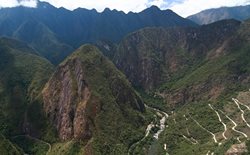
A visit to the ancient Inca ruins of Machu Picchu ranks high on many travel bucket lists, and for good reason: breathtaking views of the Andes shrouded in cloud and spiritual ancient ruins make this one of the world’s great destinations. While most visitors are content with experiencing the main site, the more adventuresome may climb the less visited Huayna Picchu for its stunning views from the summit overlooking Machu Picchu. If you are among the fortunate 400 allowed to climb Huayna Picchu each day, it’s best to be prepared with the right equipment and some time spent honing the muscles that will get you right to the top.
What to Wear and Bring
Sturdy hiking boots that have been broken in and natural fiber socks are a must for the feet. Moisture wicking layers work well for the fluctuating temperatures encountered during ascent and descent, and a change of base layer is advisable for when you reach the top. Trekking poles can be valuable for keeping your balance. A wide-brimmed hat with some form of SPF, and sunblock are essential as is a 1-2 quart water bottle that fits comfortably in your day pack. High energy snacks such as nuts, dried fruits, power bars, and trail mix will ensure that you don’t experience an energy slump halfway through.
How to Train
Climbing Huayna Picchu requires a good level of cardiovascular fitness, so after you’ve consulted your primary care physician, aim to do at least 30 minutes daily of moderate to strenuous cardio exercise such as running, cross-training, swimming, or biking. When you’ve completed your high intensity cardio, hop on a treadmill or elliptical trainer for a slower work out with a steep incline. Work slowly but steadily to increase your endurance, then try to combine incline with cardio.
Much of the climb is done by the thigh and calf muscles, so embarking on a program of weight training and body weight exercises such as squats, lunges, and reps on a lower body weight machine will help build the strength you need when you hit the trail. Personal trainer Melissa Dickson also advises travelers to pay attention to the all-important core muscles: “Core strength is vital when traveling up and down hills. One needs to keep the pressure off the lower back by having a strong core… Done consistently, these exercises are so effective.” Dickson highly recommends Pilates or yoga, as well as upping your crunches and sit ups.
Try to fit in several hikes of at least 5 miles over rough, rocky terrain with a steep incline in your area: This will get you used to the kind of hiking you will experience in Peru. Wear the boots and socks you plan to wear to ensure that they are well-broken in.
Alexander+Roberts helps many people experience Machu Picchu through immersive itineraries such as
Peru Explorer.